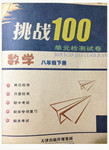题目内容
_________is going to do the job will be decided by the Party committee.
A. That B. Why C. How D. Who
练习册系列答案
 挑战100单元检测试卷系列答案
挑战100单元检测试卷系列答案
相关题目
题目内容
_________is going to do the job will be decided by the Party committee.
A. That B. Why C. How D. Who
 挑战100单元检测试卷系列答案
挑战100单元检测试卷系列答案